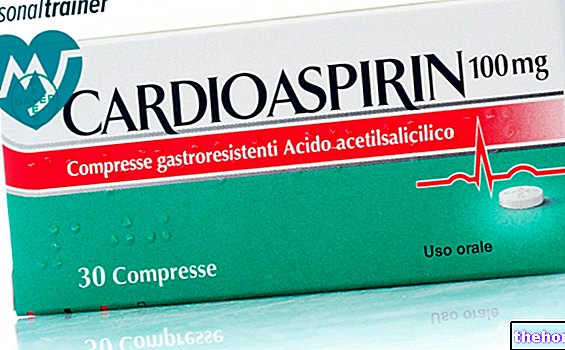Active ingredients: Diclofenac
PENNSAID Cutaneous solution
Source Package Leaflet: AIFA (Italian Medicines Agency). Content published in January 2016. The information present may not be up-to-date.
To have access to the most up-to-date version, it is advisable to access the AIFA (Italian Medicines Agency) website. Disclaimer and useful information.
01.0 NAME OF THE MEDICINAL PRODUCT
PENNSAID®
02.0 QUALITATIVE AND QUANTITATIVE COMPOSITION
1 ml of cutaneous solution contains 16.05 mg of diclofenac sodium.
For excipients, see section 6.1.
03.0 PHARMACEUTICAL FORM
Skin solution.
The skin solution is a clear, colorless to pink or orange liquid.
04.0 CLINICAL INFORMATION
04.1 Therapeutic indications
PENNSAID® (16 mg / ml of diclofenac sodium) is a cutaneous solution indicated in the symptomatic relief of pain associated with osteoarthritis of superficial joints, including the knee.
There are no data on the use of PENNSAID® in large, deep joints lined with muscle or other soft tissue layers, such as the hip or spine.
04.2 Posology and method of administration
PENNSAID® is applied locally on the painful joint.
After washing the area to be treated with soap and water and waiting for it to dry, apply about 20 or 40 drops (about 0.5 or 1 ml) of PENNSAID® (16 mg / ml of diclofenac sodium) respectively for one "joint medium (e.g. wrist) or large (e.g. knee). Patients should use up to a maximum of 40 drops four times a day per joint as recommended by the treating physician. solution by dividing it into portions of 5 or 10 drops for a "medium or large joint. Distribute PENNSAID® evenly on the area to be treated with the hand or fingers. Repeat the process until you have applied the full recommended dose of PENNSAID®. Apply 4 times a day.
Patients with renal and hepatic impairment:
For the use of PENNSAID in patients with hepatic or renal impairment see section 4.4
Pediatric use: As there are no clinical data on the use of PENNSAID® in pediatrics, it is not recommended for use in this patient group.
04.3 Contraindications
PENNSAID® (16 mg / ml diclofenac sodium) is contraindicated in pregnant and lactating women and in patients with hypersensitivity to diclofenac or to other components of the solution.
Since there may be cases of cross-sensitivity with other non-steroidal anti-inflammatory drugs, even belonging to different groups, diclofenac should not be used in those subjects in which they have occurred, after taking acetylsalicylic acid (ASA) by mouth or by other non-steroidal anti-inflammatory drugs (NSAIDs), asthma attacks, hives, acute rhinitis or other allergic manifestations.
Allergy or skin sensitivity: PENNSAID® also contains dimethyl sulfoxide (DMSO) as a carrier agent and therefore should not be used in patients with a known history of allergy or skin sensitivity to DMSO.
04.4 Special warnings and appropriate precautions for use
The occurrence of side effects can be reduced by using the lowest effective dose for the shortest time needed to control symptoms.
Elderly: In the elderly there is an "increased frequency of adverse reactions to oral NSAIDs, especially gastrointestinal bleeding and perforation, which can be fatal.
Patients with a history of gastrointestinal toxicity, particularly when elderly, should report any abnormal abdominal symptoms (especially gastrointestinal bleeding) especially in the initial stages of therapy.
Serious skin reactions, some of them fatal, including exfoliative dermatitis, Stevens-Johnson syndrome, and toxic epidermal necrolysis have been reported very rarely in association with the use of NSAIDs (see section 4.8).
In patients the greatest risk of such reactions occurs in the initial stages of therapy: the onset of reactions occurs within the first month of therapy in most cases.
PENNSAID® therapy should be discontinued at the first appearance of skin rash, mucosal lesions or any other signs of hypersensitivity.
Patients should be advised to wash their hands after application to avoid contact with eyes, mucous membranes and skin not involved in the treatment.
No other medicines should be applied to the affected area at the same time as PENNSAID®.
The chance that undesirable effects may occur following the topical application of PENNSAID® is very low compared to the frequency of occurrence of undesirable effects following oral administration of diclofenac, due to the low systemic absorption of PENNSAID®. This medicinal product should be used with caution in patients with impaired renal function as isolated cases of systemic reactions with deterioration of renal function have been observed following oral or topical administration of NSAIDs. The lowest dosage of PENNSAID® per joint should be considered.
Hepatic system:
A slight increase in liver function test values is possible following treatment with PENNSAID®. If these abnormal values persist or worsen, or if clinical signs or symptoms indicating liver disease develop, or if other manifestations (eg eosinophilia, rash) the administration of Pennsaid should be discontinued If there is a need to administer this medicinal product in the presence of severe hepatic impairment, this should be done under careful medical observation.
Use caution in the use of diclofenac sodium in patients with hepatic porphyria, as diclofenac sodium can trigger a crisis.
Gastrointestinal system:
Peptic ulcerations, perforations and gastrointestinal haemorrhages, sometimes severe and rarely fatal, in the presence or absence of preliminary symptoms, have been reported during oral or rectal therapies with non-steroidal anti-inflammatory drugs (NSAIDs). However, the maximum serum diclofenac level after topical application of PENNSAID® is low (50 times lower than that achieved after oral administration of 25 mg diclofenac). Therefore, PENNSAID® (diclofenac sodium) can be reasonably administered under close medical supervision to patients prone to gastrointestinal irritation, including those with a history of peptic ulcer induced by other non-steroidal anti-inflammatory drugs or suffering from other inflammatory diseases of the gastrointestinal tract (such as ulcerative colitis or Crohn's disease). In such cases, the doctor must evaluate the benefits of the treatment in relation to the possible risks (See CONTRAINDICATIONS and UNDESIRABLE EFFECTS).
The patient should be instructed to contact their treating physician immediately at the first signs or symptoms of gastric ulcer or gastrointestinal bleeding. These reactions can occur at any time during treatment, without any preliminary symptoms or signs.
Dermatology:
The part treated with PENNSAID® must not be covered by occlusive bandages.
PENNSAID® should be applied to skin free from lesions or infections. Do not use PENNSAID® on joint surfaces with previous skin diseases (eg psoriasis) unless advised by your doctor.
The application of PENNSAID® on the mucous membranes is not recommended.
Hypersensitivity:
The dimethyl sulfoxide (DMSO) contained in PENNSAID® can induce the release of histamine and occasionally hypersensitivity reactions have also been reported after topical administration. In the presence of any anaphylactoid reactions it is necessary to institute adequate therapy and stop the application of PENNSAID®.
Ophthalmology:
In animal studies, high doses, particularly oral, of DMSO caused abnormal changes in the lens of the eye. In primate and human studies, no such changes were observed after ocular and oral administration of dimethyl sulfoxide.
Infections:
The anti-inflammatory and analgesic effects of diclofenac sodium may mask the usual signs of infection. Therefore the doctor must pay particular attention to the possible development of skin infections localized in the area on which the patient has applied the drug.
It was found that the maximum concentration of diclofenac in the blood, after the application of the maximum dose of PENNSAID® (1ml), is less than 10 ng / ml. This value is 50 times lower than the maximum concentration of diclofenac in the blood after oral administration of 25 mg of diclofenac.
PENNSAID® contains dimethyl sulfoxide (DMSO) which can cause drowsiness and headache and can be irritating to the skin.
04.5 Interactions with other medicinal products and other forms of interaction
The interactions reported in this section were observed following systemic administration of diclofenac sodium. The risk associated with the topical use of PENNSAID® is not known, but is probably low.
Acetylsalicylic acid (ASA):
Serum levels of diclofenac may decrease when taken concomitantly with acetylsalicylic acid. The bioavailability of acetylsalicylic acid is reduced by the presence of diclofenac. Although these pharmacokinetic interactions do not appear to be clinically relevant, there is no established advantage in the concomitant use of these two drugs.
Digoxin:
Diclofenac can increase the plasma digoxin concentration. Dosage modifications may therefore be necessary.
Lithium:
Plasma lithium concentrations may increase when administered concomitantly with diclofenac (which alters the renal clearance of lithium). It may be necessary to adjust the lithium dosage.
Oral hypoglycemic drugs:
Pharmacodynamic studies have shown no potentiation of the effects due to concomitant administration with diclofenac; however, there have been isolated reports of both hypoglycemic and hyperglycemic effects on the dosage of hypoglycemic drugs.
Anticoagulants:
NSAIDs may increase the effects of anticoagulants, such as warfarin (see section 4.4).
Diuretics:
Non-steroidal anti-inflammatory drugs are known to inhibit the activity of diuretics. The concomitant use of anti-inflammatory and potassium-sparing diuretics may cause an increase in serum potassium, and therefore require periodic monitoring of blood / plasma levels.
Glucocorticoids:
Co-administration may aggravate gastrointestinal side effects.
Non-steroidal anti-inflammatory drugs (NSAIDs):
The simultaneous oral administration of two or more non-steroidal anti-inflammatory drugs may favor the onset of undesirable effects (see Special warnings and precautions for use).
Methotrexate:
Administration of non-steroidal anti-inflammatory drugs less than 24 hours before or after treatment with methotrexate should be done with caution, as these drugs can elevate blood concentrations and increase toxicity.
Cyclosporine:
The nephrotoxicity of cyclosporine may be increased due to the effects of non-steroidal anti-inflammatory drugs on renal prostaglandin.
Quinolone antibacterials:
There have been isolated reports of seizures, which may have been due to the concomitant use of quinolones and non-steroidal anti-inflammatory drugs.
Antihypertensive drugs:
Like other non-steroidal anti-inflammatory drugs, diclofenac may reduce the antihypertensive effects of propranolol, other beta-blockers, and other antihypertensive drugs.
Other Medicines:
Diclofenac sodium salt should not be used together with diclofenac potassium salt, as both are present in the plasma in the form of the same active organic ion.
Corticosteroids: increased risk of gastrointestinal ulceration or bleeding (see section 4.4)
Antiplatelet agents and selective serotonin reuptake inhibitors (SSRIs): increased risk of gastrointestinal bleeding (see section 4.4)
04.6 Pregnancy and lactation
PENNSAID® is contraindicated during pregnancy and lactation (see sections 4.3 and 5.3).
04.7 Effects on ability to drive and use machines
There have been reports of headache, dizziness, light-headedness and mental confusion following oral diclofenac therapies. Patients should be aware that such undesirable effects may occur and should be advised not to use machines and not to drive if affected.
04.8 Undesirable effects
Topical application:
The undesirable effects are divided into local, therefore related to the area of application, and systemic. Six double-blind controlled clinical studies have highlighted the following undesirable effects with a significant increase in incidence in the group treated with PENNSAID® compared to comparison group treated with placebo. At the application site, cases of dry skin (35.8% versus 6.86% in the placebo group) and rash (10.44% versus 2.86% in the placebo group) were statistically significant. Other side effects of PENNSAID®, which were statistically significant compared to placebo, are constipation (3.83% vs 0.57%), dyspepsia (8.98% vs 4%) and flatulence (4.49% vs 0, 57%).
Photoallergic reactions and contact dermatitis have been reported after topical application of diclofenac.
The systemic absorption of diclofenac sodium after topical application of PENNSAID® is very low compared to that of taking diclofenac sodium tablets. However, when PENNSAID® is applied to a relatively large area of the skin for an extended period of time , the possibility of systemic side effects similar to systemic effects caused by oral diclofenac cannot be completely excluded.Possible systemic side effects are described below.
Oral administration:
Oral administration of diclofenac causes adverse events due to both systemic and local gastrointestinal reactions.
The most serious gastrointestinal adverse events are ulceration and bleeding, while the most severe dermatological reactions, although rare, are erythema multiforme (Stevens-Johnson and Lyell syndromes). Occasional deaths have been reported, especially in the elderly.
Bullous reactions including Stevens Johnson Syndrome and Toxic Epidermal Necrolysis (very rare)
Edema, hypertension and heart failure have been reported in association with NSAID treatment.
Gastrointestinal:
Occasionally: epigastric, gastric or abdominal pain, abdominal cramps, nausea, dyspepsia, anorexia, diarrhea, vomiting and flatulence.
Rarely: gastrointestinal bleeding (bloody diarrhea, melaena, haematemesis) gastric and intestinal ulcerations with or without bleeding or perforation.
Isolated cases: affections of the large intestine (for example: non-specific hemorrhagic colitis and aggravation of ulcerative colitis or Crohn's disease), intestinal diaphragmatic constrictions, hyperacidity, stomatitis, glossitis, sticky tongue, lesions of the esophagus, constipation and pancreatitis.
Central nervous system:
Occasionally: dizziness, headaches and vertigo.
Rarely: drowsiness, malaise, impaired concentration and fatigue.
Isolated cases: Sensory disturbances including paraesthesia, memory disturbances, disorientation, insomnia, irritability, convulsions, depression, anxiety, nightmares, tremors, psychotic reactions and aseptic meningitis.
Special senses:
Isolated cases: visual disturbances (blurred vision, diplopia), impaired hearing, tinnitus and altered taste.
Cardiovascular:
Rarely: palpitations, angina and arrhythmia.
Isolated cases: aggravation of heart failure and hypertension.
Dermatology:
Occasionally: skin rashes and itching.
Rarely: hives.
Isolated cases: bullous dermatosis, erythema, eczema, erythema multiforme, Stevens-Johnson syndrome, Lyell syndrome (toxic epidermal necrolysis), erythroderma (exfoliating dermatitis), hair loss, photosensitivity reactions and purpura, which include allergic purpura.
Renal system:
Rarely: edema (facial, generalized, peripheral).
Isolated cases: acute renal failure, nephrotic syndrome, urinary abnormalities (e.g. haematuria and proteinuria), interstitial nephritis and papillary necrosis.
Hematology:
Isolated cases: thrombocytopenia, leukopenia, agranulocytosis, haemolytic anemia, aplastic anemia and anemia due to gastrointestinal bleeding.
Hepatic:
Occasional: increases (≥ 3 times above the normal limit) in AST, ALT.
Rarely: liver function changes including hepatitis with or without jaundice.
Isolated cases: fulminant hepatitis.
Hypersensitivity:
Rarely: hypersensitivity reactions such as asthma in patients sensitive to acetylsalicylic acid, eg bronchospasm; systemic anaphylactic / anaphylactoid reactions, including hypotension.
Isolated cases: vasculitis and pneumonia.
04.9 Overdose
PENNSAID® is to be administered for external use only. The low systemic absorption of diclofenac from PENNSAID® suggests that cases of topical overdose toxicity are extremely unlikely.
In case of accidental ingestion, the quantity of diclofenac sodium (900 mg) contained in a 60 ml bottle of PENNSAID® can cause transient gastric disorders and / or renal dysfunction. Absorption should be minimized as soon as possible by administering activated charcoal. Kidney and gastrointestinal functions should be monitored for possible irritation or bleeding. Complications such as hypotension, gastrointestinal haemorrhage and renal failure should be treated with symptomatic and supportive treatments. Forced diuresis may be of limited use. The amount of DMSO (36 g) would be much lower than the minimum hazard levels in humans (based on the LD50 in monkeys> 11 g / kg).
Acute exposure to DMSO from inhalation of high vapor concentrations with the use or misuse of PENNSAID® is extremely unlikely. If it occurs, it can cause irritation of the upper respiratory tract mucous membranes, wheezing, nausea or vomiting. Therapy involves the administration of oxygen or other symptomatic measures deemed necessary.
05.0 PHARMACOLOGICAL PROPERTIES
05.1 Pharmacodynamic properties
ATC classification: M02AA15,
Drug-therapeutic category:
Topical medications for joint and muscle pain
Mechanism of action:
Diclofenac sodium is a non-steroidal anti-inflammatory drug belonging to the arylacanoic acid group, with analgesic and antipyretic properties. Diclofenac inhibits the biosynthesis of prostaglandins through the irreversible inactivation of prostaglandin synthetase. This decrease in prostaglandin formation results from competition between diclofenac and arachidonic acid for binding to cyclooxygenase (prostaglandin synthetase). This may partially explain the mechanism of action. Since the anti-inflammatory activity of diclofenac is also maintained in animals who have undergone adrenalectomy, does not act through the pituitary-adrenal axis. Diclofenac is regarded as a peripherally acting analgesic.
PENNSAID® consists of sodium diclofenac in a solution also containing dimethyl-sulfoxide (DMSO) which facilitates the penetration of the drug through the skin to the underlying tissues and joints. Many mechanisms of action have been hypothesized for dimethyl sulfoxide and it is likely to act by a combination of mechanisms.
05.2 "Pharmacokinetic properties
Absorption:
Diclofenac sodium is rapidly absorbed when administered as an oral solution, rectal suppository or intramuscular injection. When given as a gastro-protected capsule, especially to be taken with food, it is absorbed more slowly. Diclofenac is also absorbed through the skin.
After topical applications of 1.0 ml of PENNSAID®, (15 mg diclofenac sodium), the mean maximum plasma concentration (Cmax) of diclofenac is 9.7 ng / ml. This concentration is reached after 24-48 hours (Tmax).
Distribution and metabolism:
Although orally administered diclofenac is almost completely absorbed, the first pass metabolism is such that only 50 - 60% of the drug reaches the systemic circulation in an unaltered form. At therapeutic concentrations it is over 99% bound to plasma proteins. Diclofenac penetrates synovial fluid and has been found in breast milk. The final plasma half-life is approximately 1-2 hours.
Diclofenac is metabolised to 4 "-hydroxydiclofenac, 5-hydroxydiclofenac,
3 "-hydroxydiclofenac, 3" -hydroxy-4 "-methoxyclofenac and 4", 5-dihydroxyclofenac.
Elimination:
Diclofenac sodium is excreted in the form of glucuronate and sulfate conjugates, mainly in the urine and bile.
The mean total urinary recovery of diclofenac after 120 hours is 3.68%. The maximum rate of urinary excretion is achieved within 24 hours and maintained for up to 48-72 hours.
Diclofenac sodium and its metabolites are eliminated primarily (60%) by the kidneys.
05.3 Preclinical safety data
From standard in vitro and in vivo tests, diclofenac sodium is not mutagenic. Long-term animal studies with diclofenac sodium showed no increase in oncogenicity.
The excipient dimethyl sulfoxide may produce local toxicity, particularly when administered in undiluted form (muscle necrosis, inflammation and edema, skin peeling following intramuscular, subcutaneous or topical administration, respectively). Dimethyl sulfoxide produced teratogenic lesions in a number of cases. of mammalian species, especially at doses of approximately 2.5 g / kg / day or higher and with different routes of administration.
06.0 PHARMACEUTICAL INFORMATION
06.1 Excipients
Dimethyl sulfoxide, ethanol, glycerin, propylene glycol, distilled water.
06.2 Incompatibility
Not relevant.
06.3 Period of validity
30ml and 60ml: 3 years.
15 ml: 18 months.
After first opening: 12 weeks.
06.4 Special precautions for storage
Do not store above 25 ° C. Do not refrigerate.
06.5 Nature of the immediate packaging and contents of the package
PENNSAID® is packaged in white low density polyethylene oval 20, 40 and 75 ml bottles (corresponding to volumes of 15 ml, 30 ml and 60 ml respectively). They are sealed with a 18 mm white low density polyethylene screw cap and a dropper with a plastic spout.
06.6 Instructions for use and handling
No particular education.
07.0 MARKETING AUTHORIZATION HOLDER
DIMETHAID (UK) LIMITED
Spectrum hause, 20/26 Cursitor tree
London, EC4A 1 HY
United Kingdom
08.0 MARKETING AUTHORIZATION NUMBER
15 ml bottle: AIC n °: 035719018
Bottle 30 ml: AIC n °: 035719020
60 ml bottle: AIC n °: 035719032
09.0 DATE OF FIRST AUTHORIZATION OR RENEWAL OF THE AUTHORIZATION
01/11/2001
10.0 DATE OF REVISION OF THE TEXT
01/02/2007























-nelle-carni-di-maiale.jpg)




